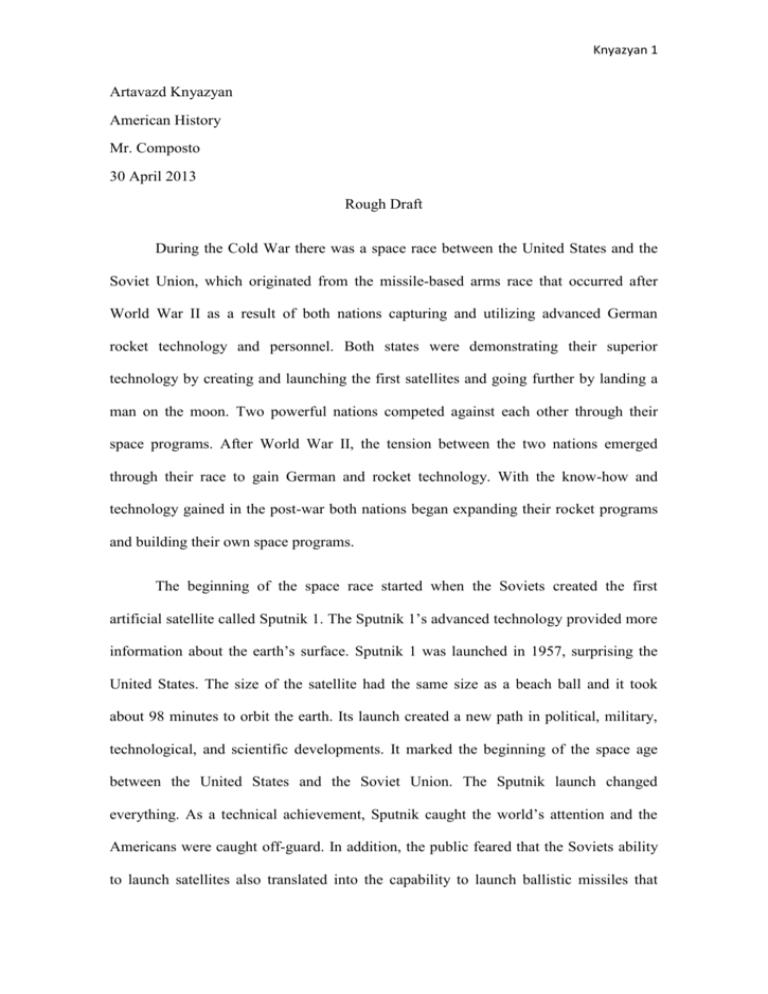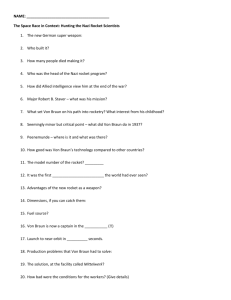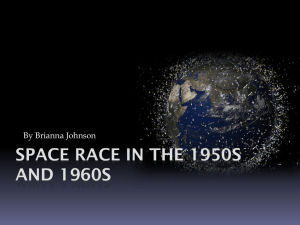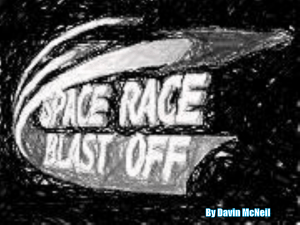File - Artavazd Knyazyan
advertisement

Knyazyan 1 Artavazd Knyazyan American History Mr. Composto 30 April 2013 Rough Draft During the Cold War there was a space race between the United States and the Soviet Union, which originated from the missile-based arms race that occurred after World War II as a result of both nations capturing and utilizing advanced German rocket technology and personnel. Both states were demonstrating their superior technology by creating and launching the first satellites and going further by landing a man on the moon. Two powerful nations competed against each other through their space programs. After World War II, the tension between the two nations emerged through their race to gain German and rocket technology. With the know-how and technology gained in the post-war both nations began expanding their rocket programs and building their own space programs. The beginning of the space race started when the Soviets created the first artificial satellite called Sputnik 1. The Sputnik 1’s advanced technology provided more information about the earth’s surface. Sputnik 1 was launched in 1957, surprising the United States. The size of the satellite had the same size as a beach ball and it took about 98 minutes to orbit the earth. Its launch created a new path in political, military, technological, and scientific developments. It marked the beginning of the space age between the United States and the Soviet Union. The Sputnik launch changed everything. As a technical achievement, Sputnik caught the world’s attention and the Americans were caught off-guard. In addition, the public feared that the Soviets ability to launch satellites also translated into the capability to launch ballistic missiles that Knyazyan 2 could carry nuclear weapons from Europe to the U.S. Then the Soviets struck again with Sputnik II, carrying heavier weight (National Aeronautics and Space administration, p.71, 1969). The launching of the Sputnik I and II, made the United States feel that they were falling behind. The U.S Defense Department responded by approving funding for another U.S satellite project from the U.S government. They began to work on the Explorer project. Explorer had carried a small scientific payload that had discovered most of the magnetic radiation belts around the earth. On January 1958, Explorer I was successfully launched and the Explorer program continued as a successful ongoing series of lightweight, scientifically useful spacecraft. The Sputnik had made the United States create NASA. In 1958, a few months after the launch, the U.S developed the Space Act which created NASA and other government agencies. (Jorden Williams J, 1957) Explorer I revolved around earth in a looping orbit that took it as close as 354km to earth and as far as 2,515km. It made one orbit every 114.8 minutes a total of 12.54 orbits per day. The satellite itself was 203cm long and 15.9cm in diameter. Its weight was 13.9kg. The launch of the Explorer I was an important moment for the country, as the Space Race with the Soviet Union was just beginning. Explorer I had returned data to the U.S. Explorer I’s ride to space came thought a complicated set of circumstances. The United States actually had at least three main rocket options for sending the satellite into space. The ones that are most remembered today are Vanguard- under development by the Navy- and Juno. A launch attempt of a similar satellite, Explorer 2 and 5 failed due to rocket stage problems, Explorer 3 and 4 both launched successfully in 1958 and transmitted science from orbit. Explorer 3 provided evidence that the Earth is surrounded by intense bands of radiation. This was the first major scientific discovery Knyazyan 3 of the Space Age. Even though the satellites are no longer working, their legacy remains. They launched the United States into space and showed that it was possible to do science from orbit. William H. Pickering, director of the Jet Propulsion Laboratory, which designed and built Explorer. James A. Van Allen, University of Iowa physicist who directed the design and creation of Explorer’s instruments and Werher von Braun, head of the U.S. Army Ballistic Missile Agency team that designed and build the Jupiter-C rocket, advanced the V-1 and V-2 rockets within Nazi domination. Von Braun, who died in 1977, would eventually become a hero to many for enabling the United States to beat Russia to put a man on the moon. The US, despite their appropriated grater rocket science talent resources had fat catching up to do from 1957 on and finally by 1969, paced the first man on the moon. There was some speculation that the Soviets were ready at the same time, but due to problems on the launch pad, failed to make their bid to the moon. The vehicle that was chosen to launch a man on the moon was the Saturn 5 rocket. Saturn 5 was used in the Apollo program that placed Neil Armstrong on the moon in July, 1969. ( McLaughlin Green, 1970) Americans and Russians had developed their space technology, but the thing is where did they get such developed rockets? The advanced technology that the two nations had gained was from Nazi Germany. The rockets that we use today for warfare, nuclear threats and the space program had their birth, in part at least, from the Nazi rocket program at Pennemunde and Mittlewerk. The Soviet Union had captured German rocket scientists at the end of World War II and sent them back to Russia, where they began to work in the rocket program. A Russian rocket designer named Sergei Korolev was the head of the Soviet space program and Wernher von Braun was the head of the U.S space programs. Both von Braun and Korolev were accomplished scientists and were instrumental in the development of technologies for space race. Nazi Germany had Knyazyan 4 developed weapons, particularly aircrafts and tanks, during the war, which gave them an advantage over other countries. Germany also developed the first cruise missiles (V-19) and rocket-powered ballistic missiles (V-2). After the war, allied powers, especially Americans, profited immensely from captured German technology and expert scientist in the development of rocket vehicles capable of space travel. The latter rocket was based on an Army rocket designed by German scientists. Von Braun is well known as the leader of what has been called the “rocket team” which developed the V–2 ballistic missile for the Nazis during World War II. The V–2s were manufactured at a forced labor factory called Mittelwerk. (Black Rabbit Books, 2006) Wernher von Braun was one of the most important rocket developers and champions of space exploration during the period between the 1930s and the 1970s. As a youth he became enamored with the possibilities of space exploration by reading science fiction and from science fact writings, prompted young von Braun to master calculus and trigonometry so he could understand the physics of rocketry. From his teenage years, von Braun had held a keen interest in space flight, becoming involved in the German rocket society. As a means of furthering his desire to build large and capable rockets, in 1932 he went to work for the German army to develop ballistic missiles. The brainchild of von Braun’s rocket team operating at a secret laboratory at Peenemünde on the Baltic coast, the V–2 rocket was the immediate antecedent of those used in space exploration programs in the United States and the Soviet Union. First flown was in October 1942, it was employed against targets in Europe beginning in September 1944. By the beginning of 1945, it was obvious to von Braun that Germany would not achieve victory against the Allies, and he began planning for the postwar era. After World War II, von Braun worked with the U.S. Army in the development of ballistic missiles. As part of a military operation called Project Paperclip, he and his Knyazyan 5 rocket team were scooped up from defeated Germany and sent to America where they were installed at Fort Bliss, Texas. There they worked on rockets for the U.S. Army, launching them at White Sands Proving Ground, New Mexico. In 1950 von Braun’s team moved to the Redstone Arsenal near Huntsville, Ala., where they built the Army’s Jupiter ballistic missile. In 1960, his rocket development center transferred from the Army to the newly established NASA and received a mandate to build the giant Saturn rockets. Accordingly, von Braun became director of NASA’s Marshall Space Flight Center and the chief architect of the Saturn V launch vehicle, the super booster that would propel Americans to the Moon. Von Braun also became one of the most prominent spokesmen of space exploration in the United States during the 1950s. (“Wernher von Braun”) Sergei Korolev was a major figure a driving force in the development of the Russian space program. Influenced by the ideas of interplanetary flight, Korolev became interested in rocketry, and in the early 1930s helped to found a rocket research group which was responsible for training numerous scientists and engineers who would later become the core of Russia's space program.He was portrayed for years as a legendary, iconographic figure that single-handedly was responsible for the early Soviet victories in the space race. Korolev was responsible for many of Russia's well-known achievements in space exploration. He helped design the rocket used for Sputnik 1, the first artificial satellite to orbit the earth. This became the most widely used rocket in the world. Another success associated with Korolev was Luna 3, which was a probe that provided the first views of the far side of the moon. In 1959 it looped around the moon, took pictures, developed them, and radioed them back to earth. This flight bolstered the prestige of the Soviet Union throughout the world. It was Korolev who led the design team responsible for Vostok, the first manned spacecraft that went up in 1961 with Yuri Knyazyan 6 Gagarin. Korolev was also in charge of the Venera 3 mission, the first spacecraft to impact on another planet. It landed on Venus in 1966, and even though it failed to return any information due to loss of contact, Venera 3 was able to relay a great deal of information about interplanetary space before it crashed. The same year, Korolev had another first when his Luna 9made the first successful soft landing on the moon. It sent back television images and showed that the feared, deep layers of lunar dust did not exist, allowing further flights and later manned missions. (Scott and Leonov, p. 53. Hardfor,d p. 135) The Cold War began when World War II ended. The Cold War was a period of time in history where Americans and Russians have been in a tense situation.The Cold War began from 1947 to 1991, were it arise political and military tension between powers dominated by the United States with NATO among its allies, and powers dominated by the Soviet Union along with the Warsaw Pact. This began after their temporary wartime alliance against Nazi Germany, leaving the USSR and the US as two superpowers with profound economic and political differences. The Cold War demonstrated that each possessed nuclear weapons and thereby threatened with mutual assured destruction and never met in direct military combat. Instead, in their struggle for global influence they engaged in ongoing psychological warfare and in regular indirect confrontations through proxy wars. The conflict was expressed through military coalitions, strategic conventional force deployments, extensive aid to client states, espionage, massive propaganda campaigns, conventional and nuclear arms races, appeals to neutral nations, rivalry at sports events (in particular the Olympics), and technological competitions such as the Space Race. The US and USSR became involved in political and military conflicts in the Third World countries of Latin America, Africa, the Middle East, and Southeast Asia. To alleviate the risk of a potential nuclear war, both sides sought relief Knyazyan 7 of political tensions through détente in the 1970s. In the 1980s, the United States increased diplomatic, military, and economic pressures on the Soviet Union, at a time when the communist state was already suffering from economic stagnation. The pressures escalated inside the Soviet Union, where Communism fell and the USSR was formally dissolved in late 1991. The United States remained as the world's only superpower. The Cold War and its events have left a significant legacy, and it is often referred to in popular culture, especially in media featuring themes of espionage and the threat of nuclear warfare. (Orwell, 1945) After World War II, the United States and the Soviet Union created a global conflict between democratics and communists. Space became a critical theater in the Cold War, were the two sides competed to best the other’s achievements in what become as Space Race. The Space Race was a mid-to-late 20th century competition between the Soviet Union and the United States. Both nations wanted to gain supremacy in space exploration which was seen as necessary for national security and symbolic of technological and ideological superiority. The Space Race involved pioneering efforts to launch artificial satellites, sub-orbital and orbital human spaceflight around the Earth, and piloted voyages to the Moon. The Space Race had its origins in the missile-based arms race that occurred just after the end of the World War II, when both the Soviet Union and the United States captured advanced German rocket technology and personnel. The Space Race sparked unprecedented increases in spending on education and pure research, which accelerated scientific advancements and led to beneficial technologies. Some famous probes and missions include Sputnik 1, Explorer 1, Vostok 1, Mariner 2, Ranger 7, Luna 9, Alouette 1, Apollo 8, and Apollo 11. (http://library.thinkquest.org/10826/spacerac.htm) Knyazyan 8 In 1962, President Kennedy was interested in the space programs and he asked for capitals in order to look forward in the space project. A quote from him ‘’this nation should commit itself to achieving the goal, before the decade is out, of landing a man on the moon and returning him safely to the earth.’’ NASA and Kennedy have been working together in order to send a man into space. Afterwards, Alan Shepard and Gus Grisson would become the first two Americans to travel into space. In 1962, John Glenn became the first American to orbit Earth in the Friendship7 capsule. He made three orbits around the earth and went back into the atmosphere landing in the Atlantic Ocean. His success helped inspire the people to start to reach to the Moon. In 1963, more astronauts were sending into space such as Scott Carpenter, Walter Schirra, and Gordon Cooper. As space exploration continued through the 1960s, the United States was on its way to the Moon. Project Gemini was the second NASA spaceflight program. Its goal were to perfect the entre and re-entry maneuvers of a spacecraft and conduct further tests on how individuals are affected by long periods of space travel. The Apollo Program followed Project Gemini. Its goal was to land humans on the moon and assure their safe return to Earth. On 1969, Neil Armstrong became the first person to step onto the lunar surface. Armstrong spent about two and half hours outside the spacecraft. The United States announced its Gemini program in 1961. In Soviet Union, Soviet engineers worked hastily in order to modify their Vostok capsules for their Vostok programs. The race continued. Voskhod I became the first multiperson capsule, launching on October 12, 1964 with Vladimir M. Komarov, Konstantin P. Feoktistov, and Boris B. Yegorov aboard. In 1965, Alexei A. Leonov made the first "walk" in space. Gemini 3, launched on March 23, 1965, was the first manned, multiperson spaceflight of the United States. With Gemini 4, which Edward H. White II earned his status as the first American to walk in space. The United States and Soviet Union now Knyazyan 9 went ahead with their plans to achieve the final goal in the space race: landing a person on the moon. The U.S. dubbed their program Apollo while the U.S.S.R. entitled theirs Soyuz union. Test flights of both Americans and Russians programs encountered tragedy. On 1967, during preparations for a low earth orbit flight, a fire inside the highly oxygenated, sealed cabin of the first manned Apollo mission resulted in the deaths of astronauts Virgil Grissom, Edward H. White II, and Roger B. Chaffee. On 1967, the parachute failed on Soyuz I as it was returning to earth. The crash killed the sole pilot of the mission, Vladimar M. Komarov. Aware of Soviet preparations for a manned lunar fly-by, NASA launched Apollo 8, the first manned expedition to the moon, on 1968. Frank Borman, James A. Lovell, Jr., and William A. Anders orbited the moon and made observations. The legendary Apollo 11 mission, carrying Neil A. Armstrong, Edwin E. Aldrin, and Michael Collins, began with its launch on 1969 aboard a Saturn V rocket. After entering lunar orbit, the Lunar Module, with Armstrong and Aldrin, separated from the Command Module (Columbia) and began its landing. (http://www.jfklibrary.org/JFK/JFK-in-History/Space-Program.aspx) In addition, the world today had changed greatly. Now the new technology that you create, the developed and shared will be around the world without having any conflicts. Today’s world is going more deeply into the government section and about the crisis as well. The competition that both nations had, they should do the same advancement but together so the world will know that there was always a friendly part and not a competitive one. Knyazyan 10 References BBC - History: Cold War. (n.d.). BBC - Homepage. Retrieved March 20, 2013, from http://www.bbc.co.uk/history/worldwars/cold Biography of Wernher Von Braun. (n.d.).MSFC History Office. Retrieved May 9, 2013, from http://history.msfc.nasa.gov/vonbraun/bio.h Explorer Information. (n.d.). History Home. Retrieved March 20, 2013, from http://history.nasa.gov/sputnik/expinfo.htm How Does a Ballistic Missile Work?. (n.d.).wiseGEEK: clear answers for common questions. Retrieved March 20, 2013, from http://www.wisegeek.com/how-does-aballistic-missile-work.htm John F. Kennedy | The White House. (n.d.). The White House. Retrieved February 3, 2013, from http://www.whitehouse.gov/about/presidents Korolev. (n.d.). Encyclopedia Astronautica. Retrieved May 9, 2013, from http://www.astronautix.com/astros/korolev.h Mission to the Planets: Explorer 1. (n.d.).California Science Center. Retrieved May 9, 2013, from http://www.californiasciencecenter.org/Exhib NASA Moon Landing - John F. Kennedy Presidential Library & Museum. (n.d.).John F. Kennedy Presidential Library & Museum. Retrieved February 3, 2013, from http://www.jfklibrary.org/JFK/JFK-Legacy/NASA-Moon-Landing.aspx Sergei Korolev Biography (1906-1966). (n.d.). How Products Are Made. Retrieved May 9, 2013, from http://www.madehow.com/inventorbios/9/Sergei-Korolev.html Knyazyan 11 simultaneous, a. f. (n.d.). The History of Satellites - Sputnik I. Inventors. Retrieved May 9, 2013, from http://inventors.about.com/library/inventor Space Program - John F. Kennedy Presidential Library & Museum. (n.d.).John F. Kennedy Presidential Library & Museum. Retrieved February 3, 2013, from http://www.jfklibrary.org/JFK/JFK-in-History/Space-Program.aspx Space Race -National Air and Space Museum Exhibition Home Page. (n.d.).Smithsonian National Air and Space Museum. Retrieved May 9, 2013, from http://airandspace.si.edu/exhibitions/gal114/ The Space Race. (n.d.). ThinkQuest : Library. Retrieved February 3, 2013, from http://library.thinkquest.org/10826/spacera The Space Race — History.com Articles, Video, Pictures and Facts. (n.d.).History.com — History Made Every Day — American & World History. Retrieved March 20, 2013, from http://www.history.com/topics/space-race Sputnik 1 - Milestones of Flight. (n.d.).Smithsonian National Air and Space Museum. Retrieved May 9, 2013, from http://airandspace.si.edu/exhibitions/gal100/









